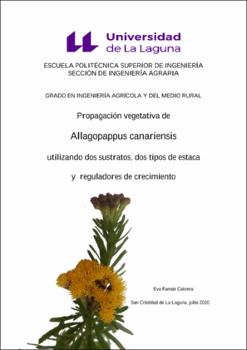Propagación vegetativa de Allagopappus canariensis utilizando dos sustratos, dos tipos de estaca y reguladores de crecimiento
Author
Farrais Cabrera, EvaDate
2020Abstract
The spread of environmental problems caused by the intentional or accidental
introduction of invasive alien species has sparked growing interest in the use of
indigenous species in gardening. Among the endemic species of the Canary archipelago
we find many examples with great ornamental interest, such as the 'madamas de risco',
name by which the two species of the genus, also endemic, Allagopappus are known.
These small shrubs of the large family of composite include for their beautiful flowering
and cultivation rusticity, as well as for the different landscaping uses that they may be
subject to.
This study was carried out with the intention of expanding the knowledge on the
vegetative propagation of one of the two species, A. canariensis (Willd.) Greuter. In a
first trial, the response to rooting of two types of cuttings, terminal and subterminal, was
analysed using two classes of substrate, earth-pyroclast (2:3) and peat-polystyrene (2:
3). A second study will compare the effect on root induction of different rootstimulating treatments: indolebutyric acid 1000 ppm and 2000 ppm along with two
commercial rooting products. The most favourable type of substrate and stake from the
first trial (2:3 peat-polystyrene and terminal stakes) was used. For both tests, cuttings
with a length between 6 and 10 cm were cut, obtained from mother plants growing in
the gardens of the facilities.
The duration of each trial, wich were carried out between autumn and winter,
was 12 weeks, with counting’s every 14 days starting the fourth week, to quantify
different variables and calculate a root quality index.
The treatment with peat and polystyrene (2:3) as substrate and terminal type
stake was found to be the most favourable for rooting with an 81.67% percentage of
rooted cuttings, of which 51.67% were transplantable. Regarding the application of
growth regulators, the best results were obtained by applying dilutions of 1000 and
2000 ppm of IBA prepared in the laboratory, obtaining rooting percentages of 81.67%
(65% transplantable) and 71.67% (61.67 % transplantable) respectively La generalización de los problemas medioambientales causados por la
introducción intencionada o accidental de especies exóticas invasoras ha provocado un
creciente interés por el uso de especies autóctonas en jardinería. Entre las numerosas
especies endémicas del Archipiélago Canario encontramos muchos ejemplos con gran
interés ornamental, como las ‘madamas de risco’, nombre con que se conoce a las dos
especies del género, también endémico, Allagopappus. Estos pequeños arbustos de la
gran familia de las compuestas destacan por su bella floración y rusticidad de cultivo,
así como por los diferentes usos paisajísticos de los que pueden ser objeto.
Se decidió realizar este estudio con la intención de ampliar los conocimientos
sobre la propagación vegetativa de una de las dos especies, A. canariensis (Willd.)
Greuter. Se analizó, en un primer ensayo, la respuesta al enraizamiento de dos tipos de
estaca, terminal y subterminal, utilizando dos clases de sustrato, tierra-picón (2:3) y
turba-poliestireno (2:3). En un segundo estudio se decidió comparar el efecto sobre la
inducción radicular de diferentes tratamientos promotores del enraizamiento: ácido
indolbutírico 1000 ppm y 2000 ppm junto con dos productos enraizantes comerciales.
Se utilizaron el tipo de sustrato y de estaca más favorables del primer ensayo (turbapoliestireno 2:3 y estaca terminal). Para ambos ensayos se cortaron estacas con una
longitud entre 6 y 10 cm, obtenidas de plantas madre cultivadas en los jardines de las
instalaciones.
La duración de cada ensayo, desarrollados entre otoño e invierno, fue de 12
semanas realizándose conteos cada 14 días a partir de la semana 4 para cuantificar
diferentes variables y calcular un índice de enraizamiento de calidad radicular.
El tratamiento con turba y poliestireno (2:3) como sustrato y estaca de tipo
terminal resultó ser el más favorable para el enraizamiento con un porcentaje del
81,67% de estacas enraizadas, de las cuales el 51,67 % resultaron trasplantables.
Respecto a la aplicación de reguladores de crecimiento, los mejores resultados se
obtuvieron aplicando diluciones de 1000 y 2000 ppm de AIB preparadas en laboratorio
obteniendo porcentajes de enraizamiento del 81,67% (65% trasplantables) y del
71,67% (61,67% trasplantables) respectivamente.





